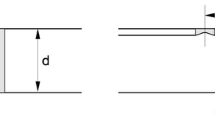Summary
The interaction of binary cyclonic vortices is investigated using the nondivergent barotropic model of Chan and Williams (1987) under two situations: a quiescent environment and a linearly-sheared background flow. It is found that the mutual interaction between the vortices results from a combination of two processes: the advection of symmetric vorticity by the asymmetric flow and the advection of asymmetric vorticity by the symmetric flow. The latter contribution is rather significant. Whether the vortices in a binary system attract or repel each other depends on the asymmetric vorticity distribution associated with the two vortices. Such a distribution is governed by the structure (size) of and the separation between the vortices. In the presence of a sheared flow, the contribution from the advection of asymmetric vorticity by the symmetric flow may also become appreciable depending on the structure and magnitude of the shear. Furthermore, the geographical locations of the vortices in relation to the sheared flow are also important in determining the relative movement of the vortices.
In the presence of β, the movements of the vortices are modified by the northwestward β-drift However, the relative motion between the vortices is almost identical to that on an f-plane. In other words, the mutual interaction between the vortices is largely independent of β. Alternatively, the two vortices can be considered to be one system which drifts towards the northwest under the influence of β while they interact with each other within the system. Physically, this independence arises because the two relative vorticity advection terms have much larger magnitudes than the planetary vorticity advection term. However, the β-effect is still important in that it modifies the asymmetric flow associated with each vortex and hence the asymmetric vorticity. Such modifications change the advection patterns compared with the β=0 case and hence lead to different vortex movements. The presence of a linear shear causes the binary system to move as if it was a large (for a cyclonic shear) or smaller (for an anticyclonic shear) vortex under the influence of β.
Similar content being viewed by others
References
Brand, S., 1970: Interaction of binary tropical cyclones of the western North Pacific Ocean.J. Appl. Meteor.,9, 433–441.
Carr, L. E. III, Elsberry, R. L., 1992: Analytical tropical cyclone asymmetric circulation for barotropic model initial conditions.Mon. Wea Rev.,120, 644–652.
Chan, J. C. L., 1991: A preliminary analysis of the performance of global and regional models during the typhoon experiments in 1990. Res Rept. No. AP-91-22, Dept. of Appl. Sci. City Polytechnic of Hong Kong, 24pp.
Chan, J. C. L., Williams, R. T., 1987: Analytical and numerical studies of the beta-effect in tropical cyclone motion. Part I: Zero mean flow.J. Atmos. Sci.,44, 1257–1264.
Chan, J. C. L., Lam, H., 1989: Performance of the ECMWF model in predicting the movement of Typhoon Wayne (1986).Wea. Forecasting,4, 234–245.
Chang, S., 1983: A numerical study of the interactions between two tropical cyclones.Mon. Wea. Rev.,111, 1806–1817.
DeMaria, M., 1985: Tropical cyclone motion in a nondivergent barotropic model.Mon. Wea. Rev.,113, 1999–1210.
DeMaria, M., 1987: Tropical cyclone track prediction with a barotropic spectral model.Mon. Wea. Rev.,115, 2346–2357.
DeMaria, M., Chan, J. C. L., 1984: Comments on “A numerical study of the interactions between two tropical cyclones”.Mon. Wea. Rev.,112, 1643–1645.
Dong, K., Neumann, C. J., 1983: On the relative motion of binary tropical cyclones.Mon. Wea. Rev.,111, 945–953.
Dritschel, D. G., Waugh, D. W., 1992: Quantification of the inelastic interaction of unequal vortices in two-dimensional vortex dynamics.Phys. Fluids A,4, 1737–1744.
Evans, J. L., Holland, G. J., Elsberry, R. L., 1991: Interactions between a barotropic vortex and an idealized subtropical bridge. I. Vortex motion.J. Atmos. Sci.,48, 301–314.
Florino, M., Elsberry, R. L., 1989; Some aspects of vortex structure in tropical cyclone motion.J. Atmos. Sci.,46, 979–990.
Fujwhara, S., 1923: On the growth and decay of vortical systems.Quart. J. Roy. Meteor. Soc.,49, 75–104.
Holland, G. J., Dietachmayer, G. S., 1993: On the interaction of tropical-cyclone-scale vortices III: continuous barotropic vortices.Quart. J. Roy. Meteor. Soc.,119, 1381–1398.
Melander, M. V., Zabusky, N. J., McWilliams, J. C., 1988: Symmetric vortex merger in two dimensions: Causes and conditions.J. Fluid Mech.,195, 303–340.
Richie, E. A., Holland, G. J., 1993: On the interaction of tropical-cyclone-scale vortices II: Discrete vortex.Quart. J. Roy. Meteor. Soc.,119, 1363–1379.
Smith, R. K., Ulrich, W., Dietachmayer, G., 1990: A numerical study of tropical cyclone motion using a barotropic model. I: The role of vortex asymmetries.Quart. J. Roy. Meteor. Soc.,116, 337–362.
Ueno, M., 1991: Causes and improvements of bias in tropical cyclone track forecast by JMA NWP models.ESCAP/WMO Tropical Cyclone Annual Review, Typhoon Committee Secretariat, UNDP, Manila, Philippines, 123–133.
Ulrich, W., Smith, R. K., 1991: A numerical study of tropical cyclone motion using a barotropic model. II. Motion in spatially-varying large-scale flows.Quart. J. Roy. Meteor. Soc.,117, 107–124.
Waugh, D. W., 1992: The efficiency of symmetric vortex merger.Phys. Fluids A,4, 1745–1758.
Williams, R. T., Chan, J. C. L., 1994: Numerical studies of the beta effect in tropical cyclone motion Part II: Zonal mean flow effectsJ. Atmos. Sci.,51, 1065–1076.
Author information
Authors and Affiliations
Additional information
With 22 Figures
Rights and permissions
About this article
Cite this article
Chan, J.C.L., Law, A.C.K. The interaction of binary vortices in a barotropic model. Meteorl. Atmos. Phys. 56, 135–155 (1995). https://doi.org/10.1007/BF01022526
Received:
Revised:
Issue Date:
DOI: https://doi.org/10.1007/BF01022526




